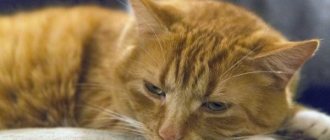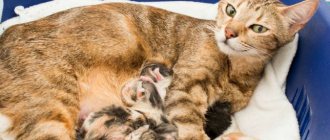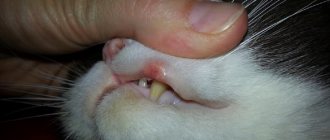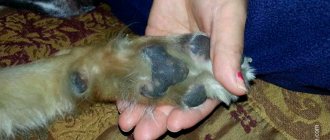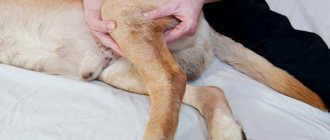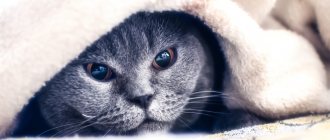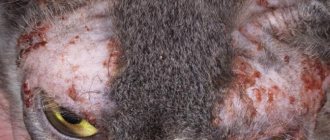It is no secret that purebred animals often suffer from hereditary diseases. Selective selection in order to consolidate certain human-needed qualities in a breed is costly for our pets. One of the most common hereditary anomalies is articular dysplasia in cats. This disease significantly limits the animal's mobility. It appears more often in infancy and progresses as quickly as the kitten gains weight. Cats of large breeds - Maine Coon, British, Persians - especially suffer from the disease. According to the International Orthopedic Foundation for Animals (IFAW), the average incidence of this disease among cats is 6.6%.
General information about the disease
Joint dysplasia is a congenital defect that arises as a result of improper formation in the embryonic and postnatal period. It consists of a discrepancy between the head of the hip or ulna and the glenoid cavity. As a result, a pathological gap is formed between them, which is why the joint cannot work effectively.
There are two types of dysplasia in cats:
- Hip dysplasia. It occurs most often and represents a pathology of the hind limbs of the animal.
- Elbow dysplasia is less common. It represents mainly pathologies of the proximal processes of the ulna.
Hip dysplasia (HJD)
The hip joint is formed by the head of the femur, the acetabulum (the depression formed by the hip bones) and the acetabulum (a special cartilaginous plate). The ligamentous apparatus that holds the femoral head in the socket consists of the articular capsule, round ligament and acetabular labrum.
The pathology consists of underdevelopment of the joint, the degree of which can vary from increased mobility with a deficiency of connective tissue and weakness of the ligamentous apparatus to gross disorders. Lack of adequate treatment can lead to severe complications, which are characterized by dysfunction of the hind or forelimbs, up to complete loss of mobility.
Complications may be of the following nature:
- Subluxation of the hip. The femoral head cannot be held in its proper place by the ligamentous apparatus. It moves outward and upward. Its partial displacement relative to the acetabulum is called traumatic subluxation.
- Hip dislocation. Complete loss of contact between the femoral head and the acetabulum, in which the latter folds into the joint. Over time, the acetabulum can fill with connective tissue, causing the dislocation to become irreducible.
- Arthrosis of the hip joint. It occurs when improper articulation leads to constant contact between the femur and acetabulum and their mutual injury. The bone is gradually destroyed, the cartilage loses its elasticity.
- Pelvic deformity. It occurs with bilateral dysplasia. When both joints are affected, over time one limb becomes deformed relative to the other.
Permission to breeding
Due to the fact that dysplasia of the hip and elbow joints in cats is of a hereditary nature, it became necessary to control the possibility of breeding animals. To determine it, a special rating scale is used.
According to this scale, there are five degrees of dysplasia:
- Grade “A” indicates healthy joints without signs of deformation.
- Grade “B” is assigned when there are minor changes without significant clinical manifestations.
- Grade “C” is given to animals with the initial stage of the disease and mild clinical manifestations.
- Grade “D” is reserved for animals suffering from severe joint deformities.
- Grade “E” means that irreversible changes have occurred in the joints, as a result of which the animal has become disabled.
Animals with stages A, B, and C are allowed for mating. An expert assessment is carried out with the participation of representatives of the Orthopedic Animal Foundation when the animal reaches the age of 1.5 years.
Description of the disease hip dysplasia in cats
First of all, it should be said that any dysplasia is nothing more than the incorrect formation and subsequent development of a tissue or organ.
As for hip dysplasia itself, not so long ago it was believed that cats do not suffer from it at all.
However, as it turned out, this is far from the case, and that, according to statistics, purebred cats, and, in particular, large cats such as Maine Coon, Norwegian Forest, British and Persian, are most susceptible to this disease.
As for the Scottish Fold, despite the fact that the Scots are much smaller than the British, due to a mutation that causes sagging ear cartilage, this breed is prone to several serious diseases of the musculoskeletal system, among which is dysplasia hip joints.
What is this pathology? The fact is that with this disease, the femur, due to improper formation and development, cannot be correctly combined with the pelvic bones: a free space is formed between it and the pelvic cavity.
This first leads to damage to connective tissue, such as cartilage, and then the bones begin to deform.
Important!
Hip dysplasia cannot be diagnosed at an early age, as it will only manifest itself as the kitten gets older. However, if this disease was diagnosed in close relatives of the baby, then the likelihood of its occurrence in a growing pet will be incomparably higher than if it belonged to a line free from this disease.
Types of hematomas and their differences
Pathology on the part of the joint is a displacement of the bones that form the organ from its anatomical position. In this case, damage occurs to soft tissues, blood vessels, ligaments, and adjacent tendons.
In addition to congenital and acquired forms of the disease, veterinarians distinguish between complete and incomplete joint pathology. With complete dislocation, the end parts of the bones involved in the formation of the joint do not touch each other.
With an incomplete form (subluxation), the bones retain the ability to touch.
If, when the joint is damaged, there is no violation of the integrity of the skin, then experts talk about a simple dislocation. The pathology is complex, accompanied by intra-articular fractures, ruptures of ligaments and tendons.
Symptoms of the disease
The first signs of dysplasia are often noticeable at an early age and increase with weight gain. Elbow dysplasia is usually visible from six months of age. The situation is aggravated by the presence of concomitant pathologies. When making a diagnosis, you should never rely only on the external manifestations of the disease. They should always be supported by instrumental examination methods, among which the main one is radiography.
The main symptoms of hip dysplasia are the following disorders:
- limited movement of limbs;
- muscle weakness, worsening after exercise;
- occasional lameness;
- severe pain syndrome;
- valgus (X-shaped) curvature of the limbs;
- crunching when the joint is working.
You can also notice painful changes in the behavior and appearance of the ward:
- the joint is inflamed and enlarged;
- the cat is tense during movement, meows in pain, avoids active games;
- characteristic (wobbly) gait, falling to one side when walking;
- emaciation of the affected limbs.
In cats with developed muscles, clinical symptoms may be completely absent. Strong muscles completely compensate for weakness and stiffness of the joints. Dysplasia in such animals can only be determined by x-ray.
Dysplasia in cats - what does this disease look like?
Dysplasia of the hip joints is a complex pathology, the essence of which is that there is a mismatch between the articular head and the socket. And, although veterinary medicine has not yet established the exact causes of the development of dysplasia in cats, however, there are a number of factors that can create favorable conditions for the development of dysplasia.
Symptoms
Oddly enough, cats are animals that are much more resistant to pain when compared to dogs . Cats are able to endure for a long time without showing any signs of discomfort or pain reaction. The owner should be wary if his pet, who previously did not disdain to play and run around, began to spend much more time lying in one place.
In addition, even the most resilient animals with severe damage to the joints begin to limp, and it is difficult not to notice this. Let us list the main signs of arthritis and arthrosis:
- The cat's reluctance to jump on chairs, climb stairs, etc.
- You may notice that even after a short rest the cat finds it difficult to get up and it hurts to walk.
- During daily toileting, the animal devotes a lot of time to frequent and prolonged licking of the joints.
Note! The main sign of something wrong in this case is a sharp reduction in physical activity.
The cat tries to sleep more and walk less. Even if before the disease the animal was a good mouse catcher, then if pathology of the joints occurs, the mice can sleep peacefully: the cat obviously will not hunt. Also, the cat may become irritated, hiss and even scratch when trying to pet it.
If no help is provided to the animal, signs of exhaustion soon begin to appear, the pet does not take good care of its fur (it simply hurts to even lift its paw). Most often, the cat lies and constantly licks its sore limbs. And further. Since the animal practically does not walk or run, its claws become greatly enlarged (due to the lack of natural grinding).
Causes of the disease
The main cause of the disease is hereditary predisposition. The disease is transmitted to the kitten from one of the parents. They say that the mutation that causes symptoms of dysplasia can manifest itself after 14 generations, so before mating you need to very carefully study the pedigree of the animal.
Genetic studies have shown that there is no specific gene responsible for the presence or absence of this disease. The cause of the disease is hidden disturbances in the number or structure of chromosomes that arise during the fertilization stage. Such violations always lead to deviations in the functioning of various organs and systems. That is why more and more genetic abnormalities and hereditary diseases of cats are being identified, characteristic of some specific breeds or groups of breeds.
Provoking factors
DTHD can be provoked by a whole complex of various predisposing factors, the main of which is the significant weight of the animal and its rapid growth. That is why Maine Coon cats, which are the largest cats, are more susceptible to the disease than other cat breeds. According to research by the International Orthopedic Foundation for Animals, the incidence of dysplasia among individuals of this breed is 18-25%.
And yet there are several more breeds that are most susceptible to this disease:
- British;
- Persian;
- exotic;
- Siamese;
- Scottish Fold (Scottish Fold).
Among other provoking factors, the most important are:
- obesity;
- various bone diseases;
- consequences of previous injuries;
- early sterilization of the animal, which promotes weight gain;
- incorrectly composed diet, excessively rich in calories;
- physical inactivity.
There is a hypothesis that dysplasia can be triggered by insufficient hyaluronic acid in the synovial fluid, which serves as a lubricant for joints.
Causes of dysplasia in cats
Thus, some experts believe that kittens of those breeds that grow intensively and quickly (for example, cats of the Asher breed) are more susceptible to this disease.
There is also a high probability that dysplasia is hereditary.
If we consider these 2 versions using the example of fairly large Maine Coon cats, then representatives of this cat breed are really large in size and grow quickly, and at the same time, these cats actually suffer from dysplasia more often.
So, it is likely that these 2 factors - rapid growth and heredity - do influence the health of cats. However, why does dysplasia also occur in representatives of other cat breeds - smaller ones? Unfortunately, experts still do not have an answer to this question. They can only guess what caused hip dysplasia. However, if you see that your cat belongs to a large breed, it is recommended that she undergo regular preventive examinations at a veterinary clinic in order not to miss the onset of the disease and to begin treatment in a timely manner. Read more about breed cat diseases here.
Dislocation in a cat - what to do, how to diagnose?
A dislocation is an abnormal arrangement of anatomical structures relative to each other. When a joint is dislocated, the bones move relative to each other without damaging them. Dislocation is accompanied by damage to the soft tissues around the joint: blood vessels, joint ligaments, its capsule, and tendons of adjacent muscles are torn.
In order for a healthy joint to dislocate, significant effort must be applied, and most often in dogs and cats dislocations occur as a result of various injuries.
- auto injury;
- playing injury;
- getting limbs into holes;
- getting a limb stuck while moving;
- falling from a great height;
- collision with an obstacle at high speed.
What does a dislocation look like?
With a congenital dislocation, the main symptom is lameness; with a traumatic dislocation in cats, the animal cannot lean on the paw, which is unnaturally deployed and swollen. After an injury, the cat jumps on three legs.
X-ray of a dislocation in a cat Diagnosing a dislocation
Congenital dislocations and subluxations develop due to a genetic marriage of abnormal joint structure. Often these pathologies are recognized already in adulthood (6–8 months and older), sometimes as an accidental finding. From the practice of a veterinarian: The most common traumatic dislocations are the hip, elbow, and in cats, the jaw and wrist joints.
Externally, upon careful examination, you can see: swelling, asymmetry and deformation of the contours of the damaged joint (compared to the limb on the opposite side). in case of dislocation of the lower jaw - misalignment of teeth. Palpation during traumatic dislocations is difficult - when palpated, the animal experiences sharp pain.
A characteristic symptom is elastic (“rubber”) fixation of the joint, which normally works like a lubricated hinge. You can also feel bone-on-bone friction, grinding, clicking, and displacement of anatomical landmarks (for specialists).
- Do not try to correct the dislocation yourself - it is painful and can worsen the animal’s condition.
- Before visiting the doctor, try to immobilize the animal and the injured limb - place it in a cage, box, or carrier.
- It is necessary to avoid using the sore paw, do not knead it, do not shift it again or disturb the cat.
- Place ice or something from the freezer on the injured limb for 20–30 minutes, after wrapping it in a towel.
- Do not force feed or water the animal - anesthesia may be required.
- If your pet is in a lot of pain, give a “Travmatina” injection, it will numb the pain and partially relieve swelling (used for bruises and dislocations, a wide range of applications), and treat the joint with “Trauma-gel”
- As soon as possible, take the cat to a clinic where there is an orthopedist, an x-ray, and an operating room.
The urgency of first aid is due to the fact that a day or two will pass, the muscles will contract, a dense blood clot will form in the joint cavity, the tissue will begin to scar, and the cat will be guaranteed surgery. The more time passes from the moment of dislocation, the more difficult it is to straighten the joint.
If more than 2-3 weeks have passed after the injury, the joints, as a rule, cannot be restored. In such cases, they resort to surgery for arthrodesis (complete fixation of the joint) or resection (removal) of part of the bone to relieve the animal from pain.
There are 18 toes on the paws of an ordinary cat. Dislocation - swelling, asymmetry and deformation of the contours of the damaged joint.
There are mainly two types of treatment – conservative (closed) and surgical (open).
- Conservative reduction - the dislocation is reduced under general anesthesia - good pain relief and muscle relaxation are required. After such treatment, a control X-ray examination is performed to ensure the correct position of the bones in the joint.
- Surgical reduction is done if closed reduction is not possible. In this case, an incision is made on the joint, blood clots and destroyed fragments of the joint are removed from its cavity. After this, with the help of special levers and sometimes significant physical effort, the joint is returned to its original position
After reduction - closed or open - the joint must be fixed or immobilized. For this purpose, bandages or splints are used.
Sometimes you have to resort to a treatment method such as surgical fixation of the joint:
- special knitting needles - needed for dislocations of the hip or wrist joints,
- screws and wires for dislocation of the elbow and ankle joints.
- when the lower one is dislocated, sometimes it is necessary to sew the animal’s mouth shut for 5–10 days. It's cruel, but there's nothing you can do about it.
In rare cases, with timely reduction and minor soft tissue injuries, immobilization is not necessary.
Treatment of congenital dislocations is usually much more complicated than traumatic ones and is almost always surgical. Although congenital dislocation of the patella in dwarf dog breeds may not require treatment at all.
We hope that you will never need this information. If trouble happens and your pet gets sick, don’t waste expensive time on correspondence and consultations over the Internet - go to the doctor!
Diagnosis of dysplasia in cats
In addition to the fact that dysplasia is diagnosed based on objective symptoms, the veterinarian must conduct a number of studies that could confirm or refute such a diagnosis. First of all, blood and urine are taken from an animal with suspected dysplasia, and a full examination of these materials is carried out. It is also appropriate to take an x-ray of the area where dysplasia is in question. However, we would like to draw your attention now to the fact that
X-raying of cats under 2 years of age is strictly prohibited.
So, if dysplasia is diagnosed in a cat that is under 2 years old, you will have to do without x-rays and trust the experience of the veterinarian. Regarding the latter, no matter how good the veterinarian is, in cases where a number of additional studies can be carried out to confirm the diagnosis, he will not refuse them, because the symptoms themselves are such as a wobbling gait, pain and stiffness of movement may indicate other diseases, in particular mechanical injuries. And, therefore, it is very important to correctly establish a diagnosis and correctly prescribe a course of treatment.
Diagnosis of the disease
If the disease is caught at an early stage, then competent diagnosis will help determine the initial signs of changes. In this case, it will be much easier to cure the disease.
The main diagnostic measures are as follows:
- Visual inspection. The doctor examines the limbs, palpates them, determines the degree of damage and the presence of pathological deformities.
- General and biochemical analysis of blood and urine. They will give an idea of the general condition of the animal and the presence of concomitant diseases.
- Arthroscopy. This is a minimally invasive diagnostic procedure that allows you to assess the condition of the inner surface of the joint. A special device, an arthroscope, is inserted into the joint through a puncture. With its help, the doctor examines the intra-articular structures and assesses the degree of pathology.
- Radiography. This is the main type of joint diagnosis. It is indicated for an animal that is already 2 years old. Before the examination, the animal is put into a state of medicated sleep in order to be able to place it in the most advantageous position for a high-quality photograph.
Symptoms of dysplasia in cats
Now we invite you to familiarize yourself with the symptoms characteristic of joint dysplasia. However, I would like to immediately draw your attention to the fact that external signs should always be confirmed by a number of additional examinations (we will talk about them a little later), and only on the basis of comprehensive results and observations can an experienced veterinarian (and not you yourself) speak about the presence of dysplasia in your cat. But the symptoms listed below should alert you and serve as a reason to contact a veterinarian.
- Pronounced weakness of the cat's limbs affected by dysplasia (not necessarily the hind limbs). Limited movement (the cat cannot jump or run, or stand up; it prefers to lead a more passive lifestyle). Soreness, which is often accompanied by a plaintive meow. A wobbling gait during which the cat falls to one side. Degradation of muscle tissue on the affected limbs - the affected legs become thin.
If you notice one of these symptoms in your cat, you should not wait until dysplasia manifests itself fully. Contact your veterinarian, because treating dysplasia in the early stages is much easier than when the disease is advanced.
Diseases of the musculoskeletal system
- Purulent diseases of the joints (purulent synovitis, capsular phlegmon, purulent arthritis) are usually associated with mechanical damage to the joint and the penetration of staphylococci, streptococci and other infectious agents into its cavity. Maine Coons are lively and active cats, so the risk of injury is real for them. A wound forms on the surface of the joint, from which pus is released. The coon's temperature rises, he does not step on the injured limb and licks the wound. Treatment consists of treating the wound with antibiotics, applying a sterile bandage and fixing the damaged paw with a splint.
- Deforming inflammation of the joint is the proliferation of bone tissue that disrupts the functioning of the joint. The disease most often affects the knee and hip joints of older animals. In certain situations, surgery may be prescribed, but more often the pet is recommended to reduce the load on the joint.
- Osteoarthritis is also more common in older Maine Coons. Treatment consists of reducing the load on the joint and eating a nutritious protein diet with the addition of vitamins.
Factors contributing to the development of dysplasia
One of the main reasons for hip dysplasia in a cat is heredity. Moreover, as it was found out after research conducted by scientists, the dysplasia gene can be passed on to kittens even if both their mother and father are completely healthy. And the disease could be passed on to children “by inheritance” from their very distant ancestor, since dysplasia is sometimes transmitted even after 15 generations.
But the development of this disease is not always associated with heredity. And among other reasons for its appearance, one can also name:
- Very early castration or sterilization, due to which bone growth was slowed down.
- Excess weight, leading to increased stress on the joints and their subsequent deformation.
- Injuries to the paws or spine.
- Insufficient physical activity.
- Increased growth rate of the kitten, characteristic of large breeds such as Maine Coon.
- Lack of calcium in the body.
- Rickets.
- Hormonal disorders.
- Congenital pathologies of the structure of the skeletal system and musculoskeletal system.
- Feeding exclusively meat or low-quality dry food.
Attention!
Despite the fact that scientists consider heredity to be the main reason for an animal’s predisposition to dysplasia, the gene that is responsible for this pathology has not yet been identified. There are also suggestions that the deformation of the musculoskeletal system in cats is influenced not by one, but by several genes at once.
Treatment of the disease
Depending on the stage of joint damage, different treatment methods are used. Mild stages of dysplasia (A, B and C) are diagnosed with great difficulty, since they do not cause much concern to the animal. But if you catch the disease at these stages, treatment will be more successful. There is a high probability that it will be possible to do without surgery.
Therapeutic diet
The basis of the therapeutic diet is the restriction of high-calorie foods and a sufficient amount of vitamins and microelements. The diet should contain dietary foods rich in glucosamine and chondroitin (gelatin, cartilage). Of the microelements, calcium and manganese are especially important. It is very important to monitor the animal's weight. Under no circumstances should the established standards be exceeded.
Drug therapy
The basis of drug therapy in the early stages of the disease is long-term use of chondroprotectors (Artroglycan, ArthroVet, Stride Plus). The homeopathic remedy Chondartron is also used in the form of subcutaneous injections.
If necessary, intra-articular injections of hyaluronic acid and absorbable drugs are prescribed to ease the functioning of diseased joints and relieve inflammation.
Physiotherapeutic procedures
They can be used only during the period of remission, so as not to provoke a worsening of the condition. These are procedures that relieve pain and inflammation - ultrasound, laser therapy, electrophoresis, massage.
Rehabilitation
The sore paw is firmly fixed. They temporarily limit the animal’s ability to move, depriving it of the ability to actively move, go outside, or jump. Rest promotes rapid recovery in non-advanced forms of dysplasia.
Surgery
Advanced stages of the disease (D and E) require surgical intervention. There are several types of operations for joint dysplasia. They differ in complexity and cost:
- Pectinectomy is an operation that corrects the adductor muscle of the thigh, which is deformed and becomes involved in the pathological process. This operation gives good results in kittens under six months of age.
- Triple pelvic osteotomy. The operation is performed on young animals whose bones and ligaments have sufficient elasticity and strength. Three osteotomies (artificial fractures) of the pelvic bones are performed, after which the acetabulum is rotated and fixed with a special plate so that the joint takes the correct position.
- Joint endoprosthetics. It is practiced in cats that have reached 10 months of age and have severe dysplasia. It is the replacement of a diseased joint with an artificial one (metal or ceramic). The most effective method. The downside is its high cost.
- Intertrochanteric osteotomy. Used to treat traumatic subluxations in cats and dogs. The doctor changes the angle of entry of the femur into the glenoid cavity and reduces the subluxation. This reduces the gap between the body and the neck of the bone.
- Resection of the head of the bone or resection arthroplasty. The operation is aimed at forming a false joint in the place where the head of the bone was. The connective tissue that fills the free space begins to act as a ligamentous apparatus.
Treatment of dysplasia in cats
Diet for cats with dysplasia
Treatment of this disease begins with... the fact that you will need to review your pet's diet. The specialist should prescribe him a therapeutic diet, which involves limiting the amount of fat, the correct ratio of salts, vitamins, macro and microelements. At the same time, recommendations are given based on the results of a biochemical analysis of the blood of a sick cat, and are individual in nature.
Physiotherapy
In the initial stages of the disease, physiotherapeutic procedures and massage give good results, however, if the disease is already advanced, then physiotherapeutic procedures can only worsen the animal’s condition.
Medicines and vitamins
Cat posture characteristic of dysplasia
For advanced and complex forms of dysplasia in cats, conservative therapy is prescribed, which involves drug treatment. Based on the symptoms of the disease, the cat is prescribed painkillers, vitamins, and anti-inflammatory drugs. As a rule, such a conservative method of treatment is almost always appropriate for old animals, on which it is no longer possible to operate due to the weakening of their body. However, if the animal is young, its body is strong, a conservative treatment method can be postponed as a last resort, in order to still give the cat a chance for a full recovery.
In some cases, especially for young and strong animals, the veterinarian may recommend surgery. Today in veterinary practice there are 3 types of such interventions:
- triple osteotomy, during which the damaged area of the joint is strengthened, and a special metal structure is used for strengthening; resection arthroplasty - is appropriate in case of severe degradation of the affected joint; during such an operation, the head of the femur is removed, and in its place the doctor forms a so-called ersatz from muscle tissue, in place of which a cartilaginous plate will eventually form, which will allow the cat to move normally; prosthetics – involves the elimination of the affected joint and the installation in its place of a prosthesis made of polymer or metal materials.
As for the effectiveness and features of such surgical measures, triple osteotomy is suitable for young cats without degenerative changes in the tissues; the operation gives a good result and is not expensive. Prosthetics, although expensive, is an optimal and complete solution to the problem of dysplasia, since after the operation the cat receives a healthy limb that does not cause her any more trouble. In 90% of cases, cats recover completely after such prosthetics and lead a full life, delighting their owners with active cat fun and games (all about cat games).
True, no matter what kind of surgical intervention is performed, the animal will need special postoperative care after it, the details of which are described here. And for the cat to fully recover, it will take time.
First aid and treatment of hematomas
Immediately after injury, ice should be applied to the skin. No ice? Open the freezer, take any food, wrap it in a towel and bag. Calm the cat and cool the injury for 10 to 20 minutes.
Important! The cat needs to be injected or given a painkiller.
If the wound is open, the edges are treated with iodine. On the first day or before arriving at the doctor, a pressure bandage is applied.
A closed injury is covered with an elastic bandage. Be careful when applying pressure bandages, use appropriate force and check local skin temperature.
If you suspect internal bleeding, apply ice and go to the doctor. If a limb is injured, we pull the paw above the bleeding wound and record the time.
The tourniquet is removed after a maximum of 25–30 minutes.
Absorbable ointments Levomekol, Sintomycin, Ichthyol and Vishnevsky are used locally (for suppuration). The animal is kept warm and placed on an easily digestible diet. In case of extensive hemorrhages, the hematoma is opened and “cleaned” surgically using local anesthesia.
Important! If your cat develops a hematoma for no apparent reason, contact your veterinarian. Swelling may be associated not only with vascular injury, in which case symptomatic treatment is a waste of time.
Prevention measures
Hip dysplasia is an inherited disease. Cats with a history of dysplasia in their pedigree should not be allowed to be bred. If it is assumed that the kitten will participate in breeding, an in-depth analysis of its pedigree is necessary.
If your pet has a hereditary predisposition to articular dysplasia, it is important to carefully monitor his lifestyle. This will help reduce the risk of disease to a minimum.
- It is very important to adjust the animal’s diet by eliminating excess fats and carbohydrates. Food should be moderate in calories and contain sufficient minerals.
- It is necessary to monitor the cat's weight to prevent obesity.
- Regular veterinary examinations should not be neglected.
- It is necessary to provide the animal with the opportunity to move as much as possible and play active games.
It is in our hands to make sure that pets can always feel the joy of active movement. You just need to be a little more attentive to them so as not to waste time, and start treatment as early as possible.
Dysplasia in cats
Joint dysplasia in a cat
Owners of cats, and those who do not doubt for a minute that they really should have a representative of the feline family in their home (read about the arguments for and against such a decision here) know that cats are funny and playful creatures that never let you get bored. However, in some situations, their playfulness may be limited by a dangerous disease such as hip dysplasia. On our website we have already written about hip dysplasia in dogs, but since this disease is somewhat different in cats, today we decided to talk about this disease in the feline family.
What is dysplasia, why does it appear in cats, is there a breed predisposition, what are the symptoms, how to treat dysplasia and how to prevent it - we suggest you look for answers to these questions in our publication...
Animal rehabilitation
The prognosis for recovery and the timing of a cat’s complete recovery after a dislocation depend on the following factors:
- Damaged joint.
- Severity of injury.
- Efficiency and quality of first aid.
- Time to reduce the dislocation.
- Nature of therapy (closed or surgical reduction, fixation with a bandage or knitting needles).
As a rule, in each case, the veterinarian gives individual recommendations on the timing of rehabilitation and how to support the animal during the recovery period.
The general scheme for caring for a cat after treatment for a dislocated limb will be as follows:
- Immediately after the operation, the cat can remain under the supervision of a veterinarian in the hospital for about a day. If the owner takes the animal home, then it is important to follow the recommendations for a comfortable recovery from general anesthesia - lack of anxiety, limitation of movements (especially jumping), free access to water. You can feed your cat no earlier than 12 hours after surgery.
- If necessary, in the first 3-5 days of the rehabilitation period, the animal can be prescribed painkillers and antibiotics, as well as agents that relieve swelling and inflammation.
- To speed up recovery, you can perform massage (the technique of massaging the damaged joint is simple and can be explained by a veterinarian). This improves blood circulation in damaged tissues and the joint returns to normal faster.
- In order not to aggravate the injury, it is advisable to eliminate the load on the damaged joint. To do this, the cat’s movement around the house is limited, trying to leave it in a room without high objects: jumping is contraindicated for the animal. Forced restriction of movement (for example, in a cage) is advisable only in the first 1-2 days after surgery: in the future, the cat itself controls the situation and doses the load.
- If reduction of the dislocation required surgical intervention, then the postoperative wound must be treated to avoid infection. After dense scar tissue has formed, the sutures are removed at the veterinary clinic. Important! The condition of the seam must be monitored, excluding its gnawing and “licking”. To prevent this, the seam is treated with drugs with a strong odor or a collar is placed on the animal.
- When fixing the jaw (it is required in case of complicated dislocation), it is necessary to provide the animal with full force-feeding of liquid nutritional mixtures.
On average, the time for complete restoration of mobility ranges from 3-4 weeks in young and adult animals to 5-6 weeks in older cats.

